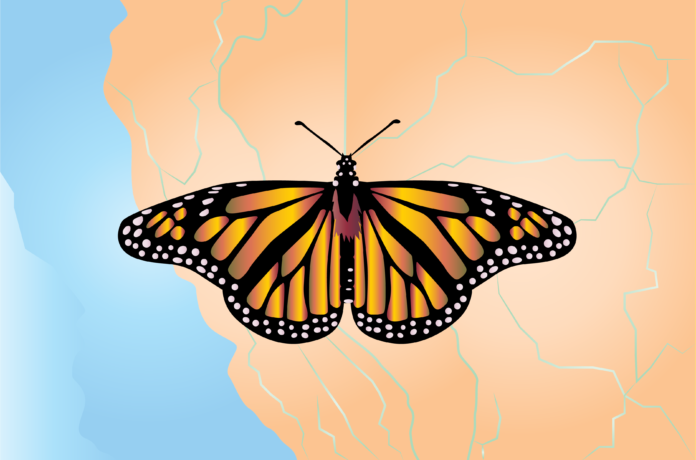UC Davis and University of Reno faculty teams work together to understand the relationship between butterfly abundance and climate change, land use and pesticides
Climate change is affecting Sierra butterflies studied on land areas not exposed to human interaction, according to a recent study led by Chris Halsch, a doctoral candidate in the ecology, evolution and conservation biology program at the University of Nevada, Reno. Halsch’s findings indicate that the changing natural environment—not direct human contact—is causing these effects, although butterflies are not always perfectly isolated from human contact.
Halsch aided in writing the recent paper detailing these results, including a review of previous literature as well as new findings in the most recent observations of butterflies. The review consisted of findings from previous studies on the topic, which had no less than 10 years of continuous sampling, examined at least 10 species and took climate change into consideration, according to the study.
The new findings were from a long-term time series that Dr. Art Shapiro, a professor in the UC Davis Department of Evolution and Ecology, started. Shapiro visited 10 sites across North Central California every other week for over 40 years to look for butterflies. It could be one of, if not the longest, insect-monitoring study in North America, according to Halsch.
Over the past four years, Halsch collected butterfly data at higher-elevation mountain sites. He and his advisor, Matt Forister, are responsible for those sites and have provided the data from recent time series of the study to add to Shapiro’s observations.
Shapiro is responsible for the creation of the Shapiro Transect, a series of 10 locations across North Central California where Shapiro monitors a variety of butterfly species activity. It benefits from the butterfly season occuring all year round at sea level, according to Shapiro.
“At an interval of two weeks, I walk the transect and record everything I find,” Shapiro said.
According to the data, changes in fauna and timing of butterfly activity were found to correlate with climate change. Each site included in the Shapiro Transect is matched to a long-term weather station and contains chronological data available on changing weather patterns. The Shapiro Transect is very important to the study, according to Halsch.
“It is one of the two best data sets we have in the world for understanding insects decline,” Halsch said.
The other site referenced is overseen by the United Kingdom butterfly monitoring team. They have monitored hundreds of sites in their country for decades, while the Shapiro Transect mostly consists of Shapiro conducting the observations. Including the U. K. butterfly monitoring team eliminates the potential of an observer effect, which is a scenario where the observer has more impact on the findings than what the site has to offer.
Butterflies have been the source of Shapiro’s research for the past 50 years.
“They have certain advantages in this type of research,” Shapiro said.
Butterflies are large enough to study with the naked eye and do not require special equipment to see them. They are also small enough to raise in large quantities in a laboratory setting, according to Shapiro.
The conclusion of the study is that climate change negatively affects generalist butterflies—butterflies that can live in different environments— the most. The number of generalist butterflies, also called the weedy species by Shapiro, are declining in the mountains, and there are fewer moving up its slope.
This is counterintuitive, according to Shapiro, because most people would think that specialist species, ones that can only survive in one type of environment, would have the most trouble with climate change. The colonization of the mountain depends on immigration from below, but there have been observations of long-term declines in butterflies generally in low elevations in California.
The pesticide neonicotinoid, chemically related to nicotine, is an insecticide produced naturally by plants and is suspected to play a part in butterfly decline, according to Shapiro.
“Reducing the impacts of climate change is a societal problem, and it’s going to take so much work, but making an effort to plant better plants, reduce use of pesticides, not immediately remove weeds that might be good for butterflies will reduce impacts of other stressors because the threat of climate change is only increasing,” Halsch said.
The study of butterflies being negatively affected by climate change is part of a variety of other studies that include different insects that are also declining in population. Even when not all insect populations are declining, the phenomenon is widespread, according to Shapiro.
“The vast majority of insects are not pests, and the vast majority deliver important ecosystem services,” Shapiro said. “We should be concerned if insects are in decline, and we should try as good citizens to find what we as individuals could do to help.”
Written by: Francheska Torres —science@theaggie.org




